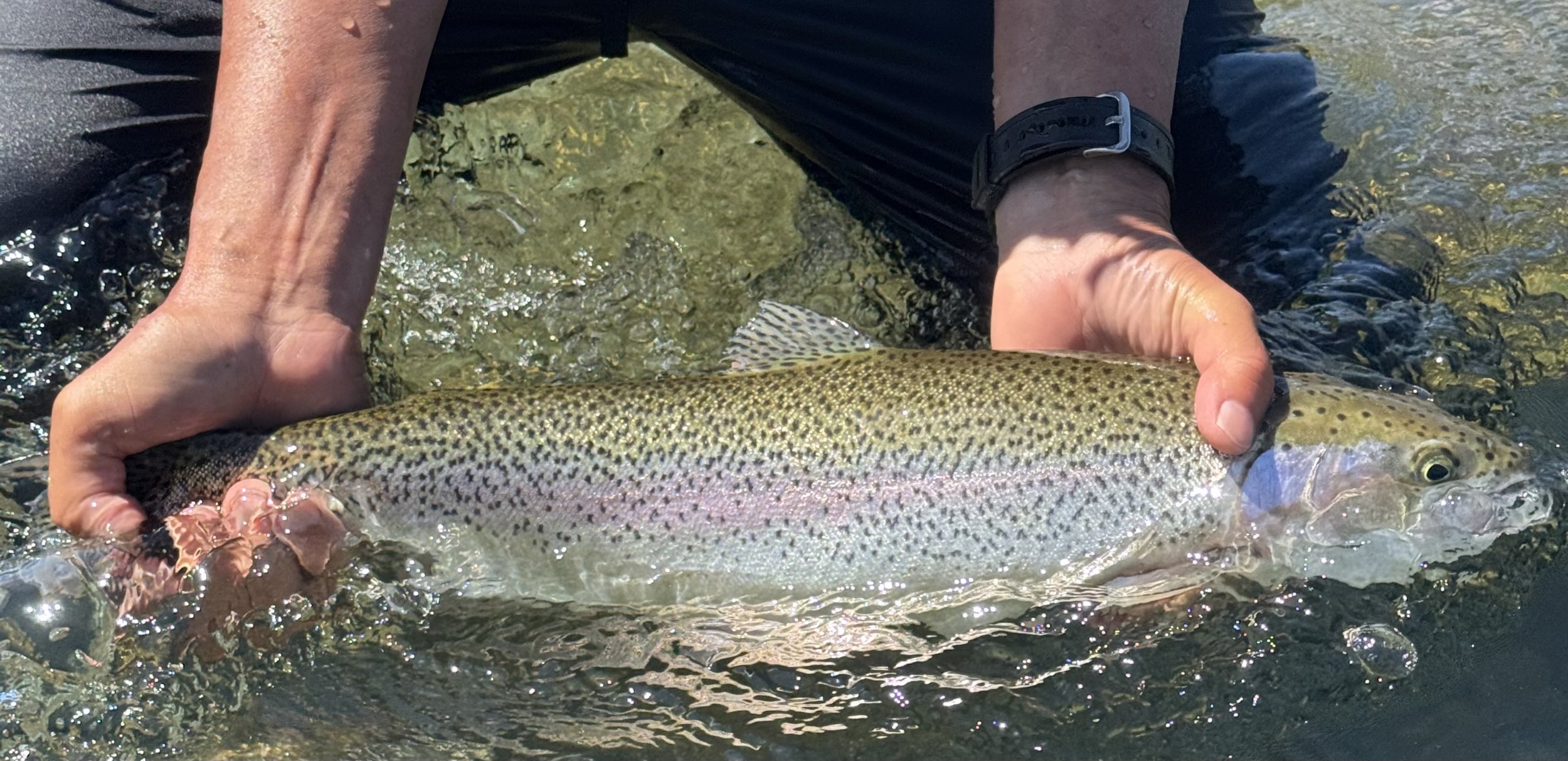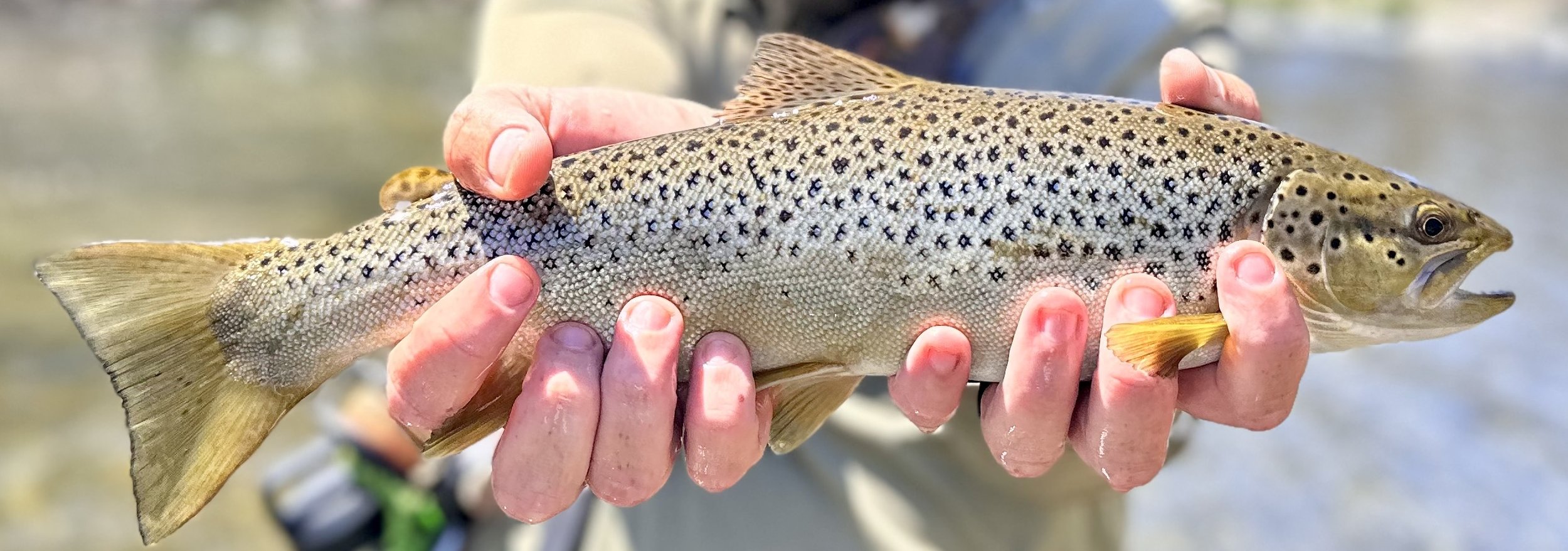When Water Hits 65 °F: Time to Hang Up Your Fly
Cold Water = Happy Trout
I’ve fished in everything from glacial runoff in Alaska to mid-summer bathwater in the Central Valley. I’ve worn five layers of fleece in June and I’ve stripped down to shorts in October. But the most dangerous water I’ve ever fished? A local creek in July that felt like lukewarm tea.
A few years back, I was fishing during a heatwave. Water looked great—clear, decent flow, bugs coming off. We hooked a chunky wild fish and had what felt like a textbook catch-and-release. Perfect net job. Quick unhook. Gentle release. But that fish didn’t bolt. It drifted. Slowly. Sideways. I watched it vanish into a deep pool, but I knew better. That fish wasn’t swimming off—it was fading out.
I still think about that fish. And every time the water temp creeps up past 65 °F, I remember what science (and guilt) taught me: fishing for trout in warm water is a losing game—for them and for us.
Let’s Get Scientific for a Second
Trout are cold-blooded, oxygen-dependent fish. That means their metabolism—and their stress level—rises with water temperature. Here’s what happens when the mercury climbs:
1. Oxygen Takes a Nosedive
Colder water holds more dissolved oxygen. At 55 °F, water can hold about 10–11 mg/L of dissolved oxygen. Trout are loving life. But at 65 °F, it drops below 8 mg/L. At 70 °F, it can fall to around 6 or less. That’s the equivalent of running a 5K with a plastic bag over your head.
2. Metabolism Spikes
For every 10 °F increase in water temperature, a trout’s metabolic rate roughly doubles. So at 65 °F, a trout’s body is burning fuel fast—but there’s less oxygen to process it. They get exhausted quicker and recover slower.
3. Lactic Acid Builds Up
During a fight, trout produce lactic acid—just like humans. But in warm water, their bodies can’t clear it fast enough. It accumulates, stressing their organs and muscles. Even if they swim off after the release, they might not survive the aftermath. This is called delayed mortality, and studies have shown mortality rates can hit 40% or higher when trout are caught and released in water temps above 68 °F.
4. Immune Systems Crash
Warm water weakens immune responses and encourages parasites like gill lice and bacteria like Aeromonas to thrive. Think of it like trout getting the flu during a heatwave—while running sprints.
You Might Be Fishing, But They're Fighting to Breathe
There are plenty of signs the trout are waving the white flag, even if you’re still throwing dry flies with hope:
No surface activity during hatches
Fish stacked in shaded, spring-fed pools
Soft, lethargic takes and long, gasping fights
And if your net feels heavier than usual? It’s probably because that fish just ran out of steam, not because it was a beast.
How to Fish Smarter When Temps Rise
Let’s get into the good habits that keep fish alive—and your karma clean:
1. Fish Early or Late
Morning water temps are lowest right after sunrise. Get your casts in early and pull off once water hits 65 °F.
And if you're thinking about sneaking out after dark? Check your local regulations. It’s illegal to fish for trout at night north of Highway 80 in California. Not worth the fine—or the Facebook shaming.
2. Size Up Your Tippet
Now’s not the time for 6x bragging rights. Use 4x or 3x to land fish fast. The longer the fight, the more stress. The more stress, the more dead trout. Period.
3. Keep ‘Em Wet and Out of the Heat
Handle fish in the water. No dry hands. No grass selfies. No “quick photo” that turns into 30 seconds of flopping and sunburn. The hotter the air, the more harm air exposure does. You don’t need the hero shot if the hero didn’t make it.
4. Carry a Thermometer
Guessing doesn’t cut it. A $12 stream thermometer will tell you exactly when to start—and stop—fishing. Water might feel cool to you, but it doesn’t take much sun to spike it into the red zone.
5. Know When to Walk Away
This is the hard part. Especially when the river looks good and you’ve got the itch. But being a good angler means knowing when to call it. There’s no shame in choosing conservation over numbers.
Bonus Tip: Go Fish for Something That Wants to Be Caught
If trout are tapped out, go fish for something that isn’t.
Smallmouth bass, carp, stripers, panfish—they’re all willing to eat in warm water, and they won’t roll belly-up after a 30-second Instagram reel.
Plus, bass don’t judge your double haul. Carp don’t care if your indicator is crooked. And stripers? They’ll just try to rip the rod out of your hand and go back to doing striper things.
Final Word
I’ll be honest—this isn’t a popular topic. Telling people not to fish sounds like bad marketing. But if we want to keep catching trout next season, and the season after that, then we’ve got to act like the water matters.
So when the temp hits 65 °F:
Go early or don’t go at all
Use thicker tippet
Keep fish wet and in the water
And if it’s too hot to be ethical… chase something that’s built for it
Because the best anglers I know aren’t the ones who catch the most fish—they’re the ones who know when not to.
Tight lines. Cool water. Smarter decisions.
Book a guided trip or join a clinic
Because every cast is an adventure, and every fish is one bad drift away from becoming a story.
Ready to Make the Cast?
If you’re feeling that tug—yeah, that one deep in your gut—you’re not alone. Whether it’s wild fish testing your patience, a steelhead peeling line and breaking hearts, Or a Weird Scaly Alien we call the Shad, this story’s best told waist-deep in moving water.
Book a trip – Come chase trout and steelhead or Bass with me, and Feel The Tug for yourself.
Join the mailing list – Get honest fishing reports, hatch updates, and tips that actually help.
Check out our clinics and resources – From first casts to advanced tactics, we’re here to make you a better angler.
Because every cast is a choice—and when you understand what’s on the other end of your line, it matters even more.



